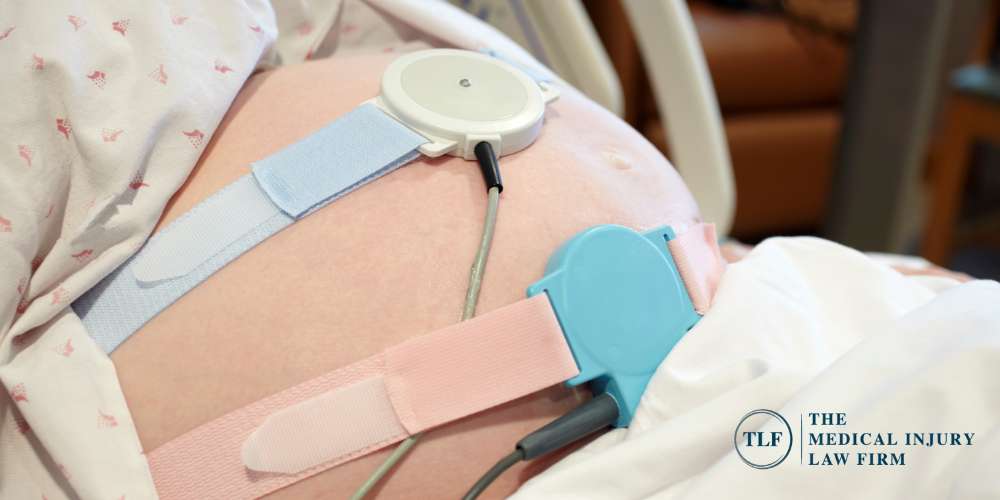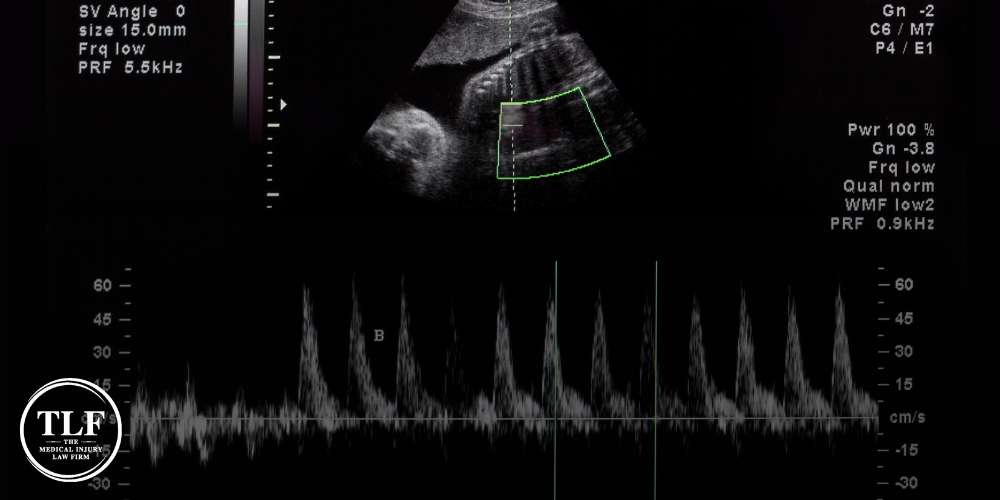Welcoming a baby into the world is an exciting and emotional journey, but what happens when something goes wrong during labor? Fetal monitoring during labor is a vital process that helps healthcare providers track the baby’s heartbeat and overall well-being during delivery so that if something does go wrong, they can identify and treat it as soon as possible.
This practice of fetal heart rate monitoring includes methods like internal monitoring and external monitoring, which allow medical teams to perform a comprehensive fetal assessment. Continuous electronic monitoring ensures that the baby is tolerating labor well and alerts providers to any signs of fetal distress. However, when fetal monitoring is improperly conducted, it can lead to missed warning signs and serious consequences for both the baby and the mother.
For families facing complications related to fetal heart rate monitoring errors, our Cincinnati, Ohio and Northern Kentucky birth injury lawyers at TLF: The Medical Injury Law Firm are here to help. Contact us online or give us a call at (800) 698-4054 to discuss your case and explore your legal options.
Why Would a Doctor Do Fetal Monitoring During Labor?
Doctors perform fetal monitoring during labor to ensure the baby is receiving enough oxygen during contractions and to identify signs of fetal distress, such as abnormal fetal heart rate patterns or reduced movement.
By closely tracking the baby’s heart rate and the strength of uterine contractions using electronic fetal monitoring or internal monitoring, healthcare providers can assess the fetal status and the baseline fetal heart rate in real time. This monitoring helps detect potential issues like umbilical cord compression, placental insufficiency, or fetal acidosis, all of which could lead to complications if not addressed promptly.
Timely action based on these observations can prevent birth injuries and improve outcomes for both the baby and the mother. If you believe that your doctor or medical staff did not perform in a timely manner and this resulted in fetal distress, the fetal distress injury lawyers at TLF are here to help get the compensation you deserve.
Types of Fetal Monitoring During Labor
During labor, doctors may use different types of fetal monitoring to track the baby’s heart rate and ensure their well-being. Electronic fetal monitoring is one of the most common methods, providing continuous information about the baby’s heart rate and any changes during contractions.
For more detailed insights, healthcare providers may use fetal scalp electrode monitoring, which involves placing a small electrode on the baby’s scalp through the birth canal when the amniotic sac is broken to measure the baby’s heart rate directly.
Another fetal monitoring method called fetal scalp pH sampling involves checking the baby’s blood pH levels to assess oxygen levels and detect potential distress when the fluid-filled sac is empty. Fetal scalp pH sampling and both internal and external monitoring techniques allow medical staff to monitor the baby’s condition and take action if complications arise.

Internal Fetal Monitoring During Labor
A more precise method used to closely track the baby’s heartbeat during labor is called internal fetal monitoring. In this process, a healthcare provider places a fetal scalp electrode directly on the baby’s scalp through the cervix. This technique requires the amniotic sac to be ruptured and is typically performed when more detailed fetal monitoring is necessary to assess the baby’s well-being.
By attaching the electrode to the baby’s head, internal monitoring provides accurate information about the baby’s condition during a vaginal delivery, especially when complications are suspected. Combined with electronic fetal monitoring, this approach helps healthcare providers make critical decisions to ensure a safe delivery.
External Fetal Monitoring During Labor
External fetal monitoring is a non-invasive method that tracks the baby’s condition during labor using sensors placed on the mother’s abdomen. Two belts are used: one sensor measures the baby’s heart rate, while the other tracks uterine contractions.
This form of electronic fetal monitoring (EFM) provides a clear picture of the fetal heartbeat and how the baby is responding to labor without requiring internal procedures.
External monitoring is commonly used in most labor settings and offers a safe and effective way to assess both the baby’s health and the progress of uterine contractions during labor.
Contraction Monitoring
Contraction monitoring plays a vital role in tracking uterine contractions during labor and delivery to ensure both the mother and baby are progressing safely. This can be done externally using a tocodynamometer, which is placed on the maternal abdomen as part of external monitoring, or internally with an intrauterine pressure catheter (IUPC) when more detailed information is needed.
Monitoring contractions helps the healthcare provider assess their strength, frequency, and duration, which can impact fetal movement and overall well-being. For low-risk pregnancies, external monitoring is often sufficient, but in cases involving complications like maternal hypotension, high blood pressure, or concerns about the umbilical artery, internal monitoring may be used.
Combined with electronic fetal monitoring, contraction monitoring provides a complete picture of the labor process, allowing timely interventions if necessary.
Intermittent Auscultation
A traditional method of fetal heart rate monitoring where the baby’s heart rate is periodically checked during the first stage of labor is called intermittent auscultation. This technique requires using handheld devices like a Doppler or fetoscope to listen to the heart rate without needing an external monitor.
Intermittent auscultation helps establish the baseline FHR (fetal heart rate) and assess how the baby responds to labor. Intermittent auscultation is often used in low-risk pregnancies, offering a less invasive way to monitor the baby while allowing more mobility for the mother.
Electronic Fetal Monitoring (EFM)
Electronic fetal monitoring (EFM) provides continuous tracking of both the baby’s heart rate and the mother’s uterine contractions. This method, often referred to as continuous monitoring or continuous cardiotocography, is typically used in high-risk pregnancies or when complications arise during labor.
By closely observing the fetal heart rate patterns, EFM can quickly identify signs of distress, such as abnormal fluctuations or decelerations of the baby’s heartbeat, allowing for timely medical interventions. This monitoring ensures a comprehensive view of the labor process and enhances the safety of both the mother and baby.
Remote Fetal Monitoring
A newer advancement in electronic fetal monitoring that has been used more recently is called remote fetal monitoring. This allows healthcare providers to track the fetal heart rate patterns and uterine contractions remotely through wireless technology. This method provides the convenience of continuous observation without requiring the mother to remain tethered to a bedside monitor.
It is especially beneficial in situations where mobility or access to advanced monitoring in a clinical setting is limited. By using fetal heart rate monitoring, remote monitoring enhances the ability to detect issues early and ensures that both the baby and mother receive the care they need, even from a distance.

What Happens When Fetal Monitoring Fails?
As a mother, you don’t ever want to think about fetal monitoring failing during birth, but what if it does? When fetal monitoring fails, it can lead to devastating consequences for both the baby and the family. Failures may occur due to improper setup or incorrect interpretation of fetal heart rate monitoring equipment, a failure to recognize or respond to signs of fetal distress, such as a high or low fetal heart rate pattern, fetal acidosis, or miscommunication among medical staff.
These oversights can result in serious complications such as brain injuries like cerebral palsy, hypoxic-ischemic encephalopathy (HIE) brain injury, or even stillbirth or neonatal death. Other preventable birth injuries, such as fetal head compression or complications linked to intrauterine growth restriction, can also occur. Situations like missed signs of uterine perforation during a vaginal examination can increase the risk of harm. Effective monitoring of the baby’s heart rate, especially during critical moments, is essential to safeguarding child health and avoiding these tragic outcomes.
If your child has been the victim of a birth injury, you may be able to file a birth injury claim to recover compensation for the harm caused by negligent medical care. The Southwest Ohio and Northern Kentucky birth injury lawyers at TLF: The Medical Injury Law Firm are here to guide you through the legal process during this emotional time.
Signs of Fetal Distress During Labor
During labor and delivery, fetal monitor readings can reveal signs of distress that require immediate medical attention. Abnormal heart rate patterns are critical warning signs, including:
- Fetal tachycardia – heart rate that is too fast
- Fetal bradycardia – heart rate that is too slow
- Late decelerations – drops in heart rate after contractions, possibly indicating oxygen deprivation
- Variable decelerations – irregular drops that may signal umbilical cord compression
Decreased variability in the baby’s heart rate may also indicate distress or compromised oxygen supply.
When fetal distress is detected, appropriate interventions may include:
- Performing an emergency C-section
- Administering oxygen to the mother
- Changing the mother’s position to improve blood flow to the baby
In high-risk pregnancies, tools like a nonstress test or external monitoring using sound waves can help identify issues early, allowing healthcare providers to act quickly to protect the baby and mother.

When Can Improper Fetal Monitoring Lead to a Birth Injury Lawsuit?
Improper fetal monitoring can lead to a birth injury lawsuit when medical malpractice occurs during labor and delivery. In the context of birth injuries, malpractice involves negligence by a healthcare provider that compromises fetal well-being or increases the risk of harm to either mother or baby (or both).
Examples include ignoring warning signs like early decelerations on the monitor, failing to act promptly on signs of distress during fetal heart rate monitoring, or inadequate documentation of the baby’s condition. Delayed decision-making, such as waiting too long to perform an emergency intervention like a C-section, can also lead to preventable injuries. Issues like unaddressed complications involving the baby’s head during labor or poor monitoring during prenatal visits may also contribute to liability.
At TLF: The Medical Injury Law Firm, our malpractice lawyers in Kentucky and Ohio can help establish negligence by analyzing medical records, consulting experts, and proving that these failures directly caused the injury and the resulting damages.
What to Do If You Suspect Medical Malpractice
If you suspect that fetal heart rate monitoring errors contributed to a birth injury, it’s important to act quickly. Start by obtaining and reviewing all medical records related to the labor and delivery. Document any concerns or unusual events you recall, and seek a second opinion if needed.
Consulting an experienced attorney who specializes in birth injuries can help you determine whether medical malpractice occurred and what steps to take next. A knowledgeable legal team like ours at TLF can guide you through the process of holding negligent parties accountable.
How Our Kentucky and Ohio Birth Injury Lawyers Can Help
At TLF: The Medical Injury Law Firm, our experienced birth injury lawyers are dedicated to helping families affected by medical malpractice and birth injuries. With offices conveniently located in Cincinnati, Ohio, and Covington, Kentucky, we provide compassionate legal guidance to those seeking justice throughout both regions.
We offer free consultations to evaluate potential cases and determine the best path forward. Our team is committed to helping families pursue compensation for medical expenses, pain and suffering, and lost opportunities caused by preventable birth injuries.

Suspect Malpractice? Contact TLF: The Medical Injury Law Firm Today for a Free Consultation
If you suspect that medical malpractice during labor caused a birth injury or the wrongful death of your child, the dedicated team at TLF: The Medical Injury Law Firm can help pursue a medical malpractice claim to get you the justice and compensation you deserve. With extensive experience in handling birth injury cases of all kinds, we are committed to guiding families in Ohio and Kentucky through this challenging time.
Contact us online or by phone at (800) 698-4054 for a free consultation to discuss your case and explore your legal options today.

